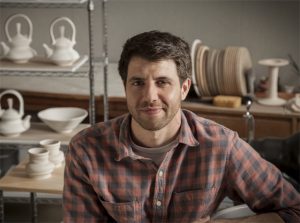Mike Jabbur
Mike Jabbur’s hands slide over the column of clay, compressing here, pulling there, his fingers scissoring to stretch open the top, the clay contorting in its spinning dance.
He pulls a disc of plastic from his rack of tidy tools and presses in the swooping swirl that makes his mugs bend and twist like bodies in motion, then smooths the lip of the vessel with a scrap of chamois whose end is snapped into an empty film canister so it doesn’t sink in the slippery slurry in which it soaks.
Jabbur (pronounced jab-oor) uses one and an eighth pounds of clay for a cup, two and a quarter for a bowl, mixed on site in the pug mill that sits between his two pottery wheels, one for stoneware, the other for porcelain, so that a speck of iron from the former can’t infect a piece of the latter and leave an unacceptable brown stain.
“A lot of people who see my work assume the process is kind of loose and casual,” Jabbur says, relaxed and lanky in his blue jeans and flannel shirt, “but I actually control as much as I can so that the kind-of casual feel isn’t a one-in-a-million success.”
Jabbur, 32, has had plenty of success. He was honored in 2011 as an “Emerging Artist” inCeramics Monthly, and his work is shown regularly in galleries as far apart as upstate New York and southern Texas, and for the past few years at the conference of the National Council on Education for the Ceramic Arts.
“His is a very distinctive style,” says Avra Leodas, owner and director of Santa Fe Clay, in New Mexico. “There’s a flow to his throwing style that has his personality all over it.”
Jabbur has made thousands of vessels, and his hands move from muscle memory, his mind focused on the spinning clay as he sings along to the Avett Brothers or Bruce Springsteen or Emmylou Harris, the volume kept reasonable so that he doesn’t disturb the artists behind the walls they share. Five days a week he’s here in his Williamsburg studio, looking out over the water, staying away only on the days he teaches and sometimes the days in between, when there are kilns to fire, clay to make, glazes to mix and classes to plan.
“Mike is very, very driven to keep his ideas flowing,” says Leodas, “and that takes a time commitment, to be in your studio and let it be happening.”
Joe Bova, a fellow ceramics artist, professor emeritus at Ohio University and Jabbur’s longtime friend and mentor, marvels at the hours Jabbur invests in his work.
“He’s an art monk,” he says, and laughs. “One thing creative people experience more than most people is that our head is full when we wake up in the morning with everything we’re going to do. Mike is one of those.”
Jabbur’s studio overlooking Lake Matoaka on the west edge of the College of William & Mary, where he is an assistant professor of ceramics, is nearly eat-off-the-floor clean, even though his medium is inherently dirty. He makes a practice of wiping and sweeping and constantly cleaning, a discipline that comes in part from his post-college job making bread in an artisanal bakery in Kansas City and in part from the undergraduate clumsiness that had him dropping blobs of clay onto pieces that were already neatly done.
“It’s a way of respecting the process,” he says, “and the product you’re making.”
His works aren’t art you dust weekly or glance at in passing, but things you hold between your palms or use as vessels for a shared meal.
“They enter daily life in a way that most other types of art don’t,” he says. “It was that relationship between the object and the way we live our life that really attracted me.”
“His is a very distinctive style. There’s a flow to his throwing style that has his personality all over it.”– Avra Leodas, Santa Fe Cla
Jabbur stank at pottery in high school. His friends were more advanced, and the younger version of himself got frustrated and gave up. A few years later he was required to take a pottery class as a graphic design major at Virginia Tech, and that time it clicked. He stayed there an extra year to get more practice, then worked at Red Star Studios in Kansas City before going after his master’s in fine art at Ohio University. After graduation, he worked for three years as studio manager at Santa Fe Clay before coming to William & Mary.
Through the years Jabbur evolved through making straightforward, functional pots, to vessels that were about pots, to sculptures that referenced pots, to nonfunctional, purely sculptural work – and now back to the kinds of pieces that people use when they’re savoring a cup of coffee or a bowl of soup.
His biggest struggle in his art is balancing aesthetics and usability; his biggest joy is emptying out the kiln and finding that one piece that’s better than he expected, whether because of the interaction of clay and glaze or a sweet warping.
“There’s nothing more exciting than emptying a kiln that went well,” he says. “That feeling is a big part of what I’m chasing in all the days that are prep work, wedging, trimming, sanding. … That’s the reward.”
Originally published in DISTINCTION, May 12, 2013

